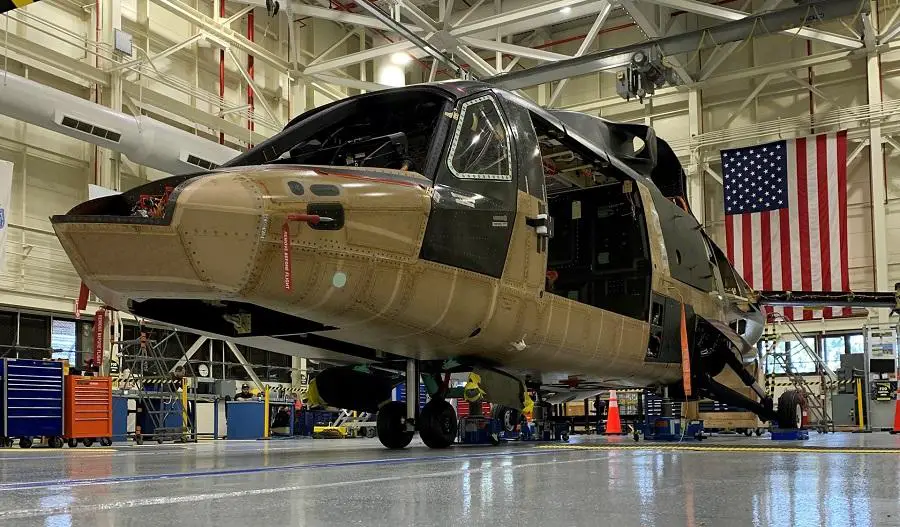The Sikorsky RAIDER X® competitive prototype (CP) for the U.S. Army’s Future Attack Reconnaissance Aircraft (FARA) is more than 85 percent complete, progressing 50 percent faster through production and assembly compared to legacy programs and resulting in a cost-effective, transformational aircraft. Sikorsky X2™ technology underpins the RAIDER X design. The compound coaxial technology of X2 provides unmatched potential and growth margin for increased speed, combat radius and payload. This enables a broader range of aircraft configurations for specific mission requirements. Sikorsky, a Lockheed Martin company, has made significant progress on RAIDER X, which is now weight on wheels at the Sikorsky Development Flight Center in West Palm Beach, Florida. RAIDER X, which Sikorsky has begun powering on, has accomplished nearly 50 percent of required System Acceptance Test procedures.
“The second fuselage has not only increased the efficiency of the build and test of our first CP aircraft, it gives us the option to build it out as a second CP aircraft, providing us with more flexibility and greater risk reduction,” said Sikorsky FARA Chief Engineer Pete Germanowski.
“Our transformational RAIDER X will deliver broad benefits to the Army including the lowest schedule risk and greatest technical maturity of the FARA competitors,” said Sikorsky President Paul Lemmo. “With X2 Technology, RAIDER X has the ability to grow, unlike a single-main rotor configuration.”
“The FARA mission requires operational flexibility, and RAIDER X provides that operational flexibility the Army needs including speed where it matters, a large multi-functional weapons bay and unprecedented acceleration and deceleration capability,” said Jay Macklin, Sikorsky business development director.

In addition, the build of Sikorsky’s second FARA fuselage is now complete. This fuselage is being integrated into Sikorsky’s structural test program and will be used to validate the flight and ground loads capability of the airframe. These tests support the RAIDER X CP flight safety program and provide data to optimize and accelerate the design for the full weapons system. RAIDER X features Modular Open System Architecture (MOSA)-based avionics and mission systems offering “plug-and-play” options for computing, sensors, survivability and weapons. X2 compound coaxial technology provides unmatched potential and growth margin for increased speed, combat radius and payload. This enables a broader range of aircraft configurations for specific mission requirements.
Established High-Tech Manufacturing Facilities: Lockheed Martin is leveraging an established, low-risk manufacturing capability augmented by a more than $600 million investment in digital thread and advanced manufacturing. This digital environment is embedded throughout the company’s engineering, manufacturing and sustainment workforce. With proven world-wide supply chain partners, RAIDER X will leverage advanced manufacturing processes currently in use today on the Black Hawk, Combat Rescue Helicopter and CH-53K. Sikorsky S-97 RAIDER: One of the primary risk reduction efforts is flight test data from the S-97 RAIDER®, which is funded entirely by Sikorsky. The S-97 RAIDER is an 80 percent-scale prototype of the RAIDER X design, and the flight test program informs design decisions, correlates to a virtual prototype and enables Sikorsky to experiment with the unique capabilities that X2 technology provides.
Digital Thread and Virtual Models: RAIDER X fully utilizes Sikorsky’s digital thread and virtual prototyping tools to maximize the capabilities RAIDER X provides to Soldiers while optimizing the aircraft’s affordability and sustainability over the life cycle. These virtual models are highly reliable, physics-based simulations of our design that provide early discovery, minimize redesign and enable future upgrades to be efficient and affordable. The implementation of such advanced processes reduced lead-time for aircraft components by over 50 percent. Lockheed Martin began manufacturing components for RAIDER X on production tooling while still in conceptual design. Then, less than a year later, completed hardware components were available for customer review, including comprehensive aircraft assembly simulations for all components.















